Submitted by Javier Lozada – www.ymcamalden.org and Anders Olson – www.bgcb.org
These plugins will mix and master for you!
Free Music Program Resources
Submitted by Javier Lozada – www.ymcamalden.org and Anders Olson – www.bgcb.org
These plugins will mix and master for you!
Submitted by Mike Lembke www.bgcb.org
If you haven’t checked out any Genius Deconstructed videos yet – get on it! “The Making of Thank U, Next” is great to share with kids and helps us remember that making music is really about having fun and sharing an emotional connection with friends, artists, and fans!
Stay up to date with the latest music trends. Below is Genius’ Deconstructed series YouTube Playlist
Submitted by Anne Joseph www.newcitykids.org/jerseycity
Anybody having a hard time getting your students to write songs? Well, for me, the Target Method really helps my kids with getting words onto paper and allowing creativity to flow. I used this method with my class, and we won the Little Kids Rock songwriting contest in our age group and category!
First you start off by drawing a 3 ring target. The most inner ring is where you write the topic of the song i.e. Food, The Beach, Love, Friendship, etc.
Then in the middle ring, you ask your students to call out words that first come to mind when you say the topic word (food) i.e. greasy, delicious, plenty, fruit, snacks, junk, tasty, fried, chips, baked.
After establishing those words, you then choose out of that middle selection one word (i.e. baked) to then expound upon in the last ring i.e. cake, dessert, apple pies, sweet, brownies, cookies, filling.
Now, you have a whole bank of words, that you came up with as a class. You task your students to write 2-4 lines using the words on the board. After some time, the students present their 2-4 lines with a melody they have come up with, or some students may rap their lines. As the teacher, you discern which melody is catchy, simple, and easily played. You also establish the notes that are being sung/played, the rhythm, beat, & the tempo.
A student’s example could be:
Thinking about food gets me hungry all the time
The grease, the taste of it is now on my mind
Chips, brownies, cakes, I would choose
Even though my mom says “Eat more fruit!”
Give it a try! And if there are other methods you use to get your kids to start writing, please let me know!
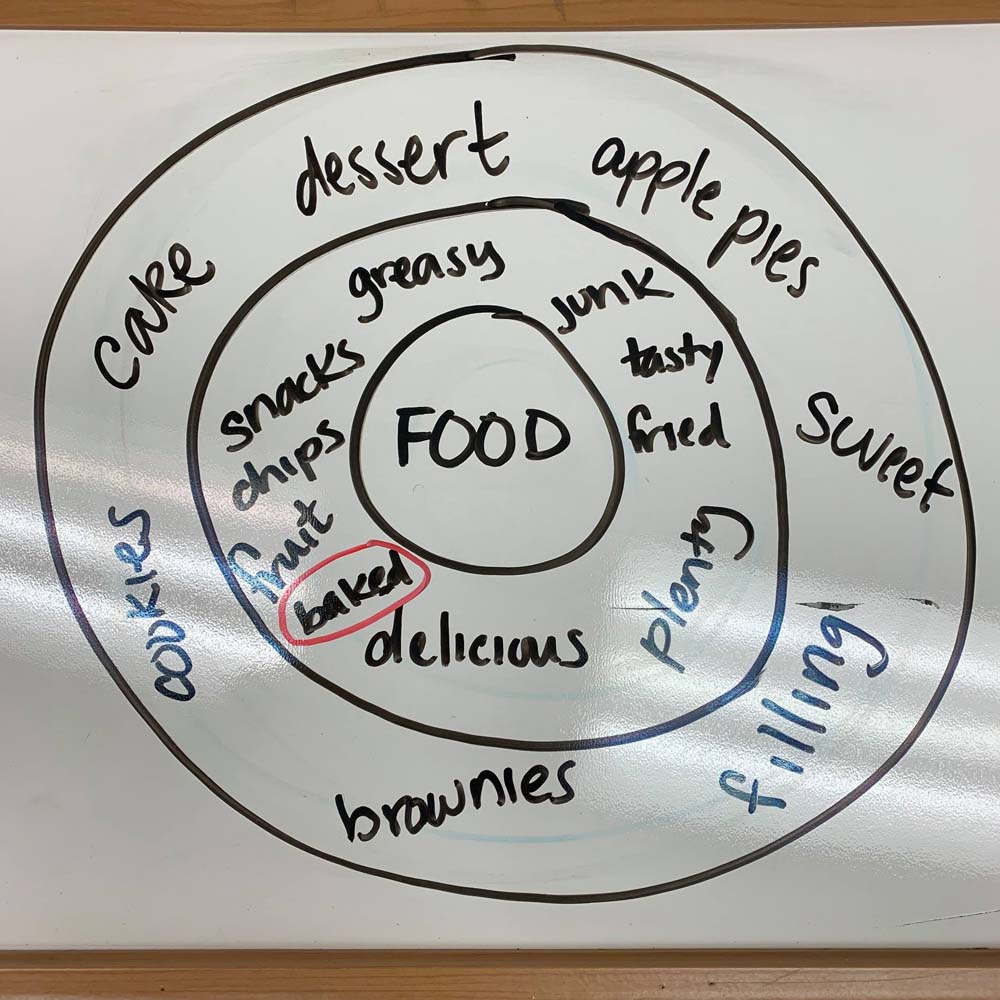
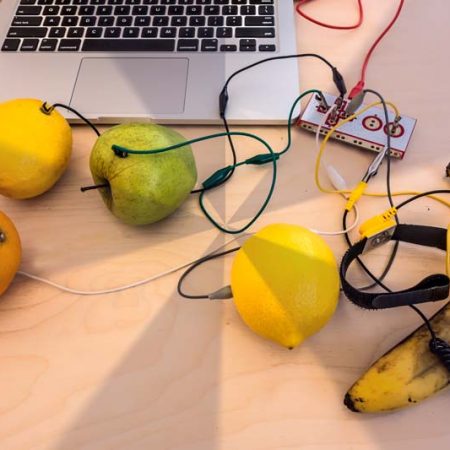
Turn apples, bananas, and muffins into drum triggers – Submitted by Javier Lozada www.ymcamalden.org
Looking for a new way to engage young participants?
Here at the Everett Studio Clubhouse, we use the Makey Makey as a way to introduce young participants into thinking about rhythm and grooves without being intimidated by the interface provided by the usual midi controller + DAW. In a sense, it provides a distraction from the pressure they may feel to “get it right” in the first try. We like to redefine lunch table beats and the use of Apple products by setting up the Makey Makey kit during their lunchtime and use the food items they are currently eating as pieces of a drum kit. The aesthetic of the kit is what usually draws young participants in to participate even if they have never shown interest in the music program. This also helps them develop 21st-century skills when they have to use logic and their knowledge in science to figure out what items could be conducive or how to wire the Makey Makes in a way that makes sense!
Items required:
The Makey Makey kit comes with proprietary software which lets you use it as a virtual instrument but here we like to use NI Battery or any other software samplers in order to be able to use custom samples which are more relatable and appropriate for the genres they are used to.
Warning: High Schoolers may love it too
Update: Using a Makey Makey kit + Logic’s musical typing I was able to pair it up with a sampler and use custom samples
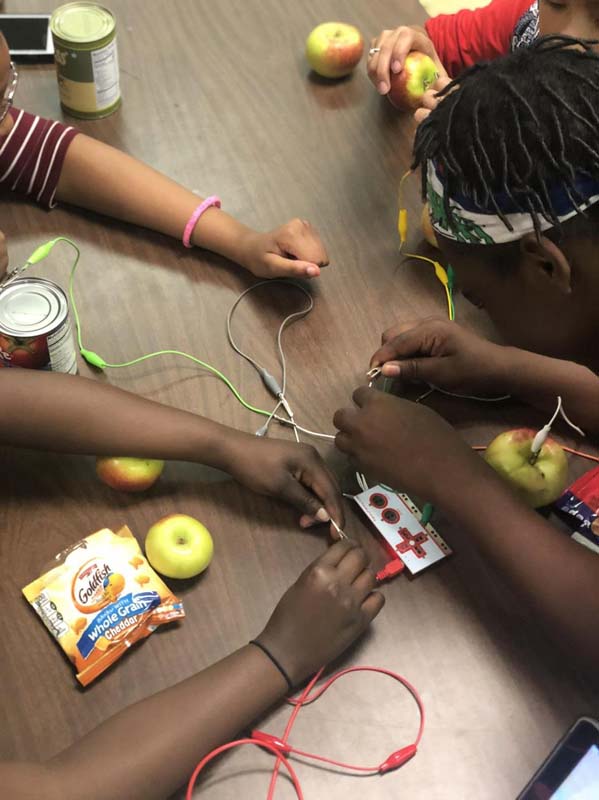
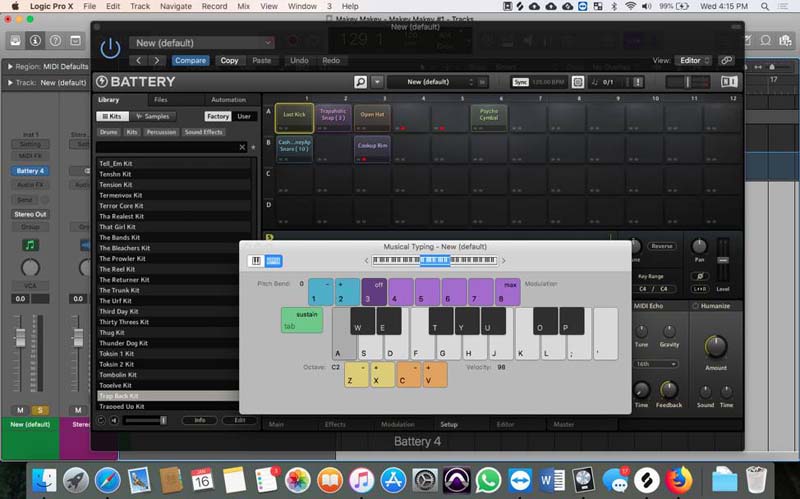
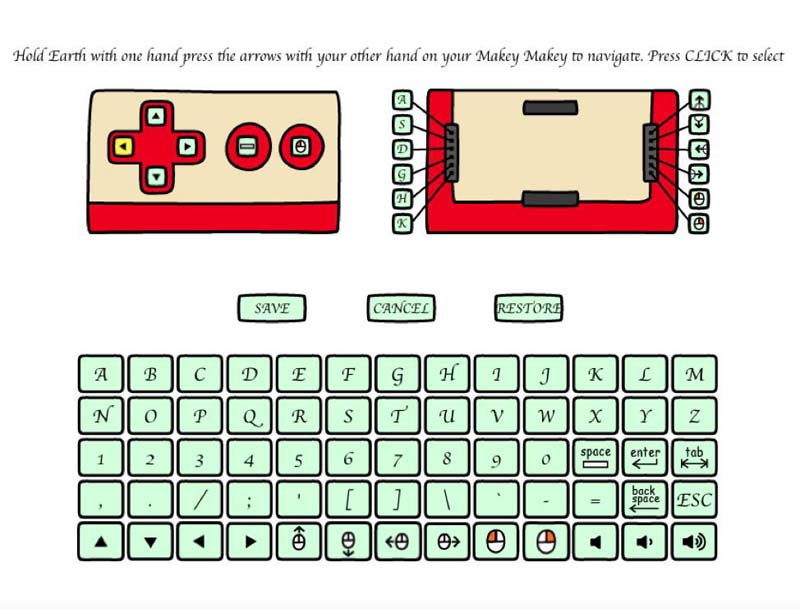
Sometimes you end up with 15 beginner participants in your studio and they all want to make a beat right now! Music Production for Large Groups gives you some tips on how to create a “patchwork quilt” music production project. This allows many different participants with different tastes, preferences, ideas and skills all to contribute to one big tapestry… your final track!
In addition participants:
Read More How to… Explore similar resources in Music Production
Page 1 of 1 (full text available in download)
To download a full, editable version
Tips for getting participants to work together as a team to complete a music production.
Objective: Encourage collaboration between participants who have specific Music Production skills
To Learn More:
Help guide an independent, solo artist through all aspects of a music production including songwriting, lyric writing, production, engineering, performance, and marketing/promoting their brand. These projects give independent and self-directed participants the freedom to produce an original album while having support from staff members along the way.
Read More How to…Page 1 of 1
| To download a full, editable version |
Explore similar resources in Music Production
Songwriting and especially lyric writing can be a daunting experience especially if a participant has never done it before. The three examples below get participants writing original songs as quickly as possible using techniques used by professional songwriters. Participants will learn basic songwriting/lyric writing skills and techniques and work as a team to create original songs/lyrics and record/perform their own original songs!
Read More How to… A “blank canvas” can be intimidating for even the most experienced artist. The following examples have built-in “creative limitations” to help keep participants focused on completing the task at hand and sets them up for success. Keep your participants accountable to work within the boundaries of the writing activity or songwriting technique and watch how it helps drive participants’ creativity. Here are 3 examples of successful songwriting activities: Example 1: “Just write” – Encourage participants to explore stream-of-consciousness lyric writing. Example 2: “Scaffolding” – Create an original song using the song form and chord changes of another song. Example 3: “Changing Perspective” – This activity places a participant/s in their peer’s shoes, encouraging empathy and shift in perspective and voice.Page 1 of 1
| To download a full, editable version |
Explore similar resources in Music Production
Help your participants understand who the key players are in the Music Industry and the insider lingo. Examples include: What’s the role of a Producer, Artists and Repertoire (A&R), Songwriter, Record Label, and Music Publishing?
Read More How to… Discuss the different roles with your participants or bring in special guest lectures: Producer Artists and Repertoire (A&R) Songwriter Record Label Music Publishing Additional Resources:
| To download a full, editable version |
| To Learn More: |
Use words that impress, without the stress, just try your best
Objective: Fun, safe, open space for participants to try freestyling
To Learn More: